ISU's vital diagnostic lab outgrows aging space with core safety flaw
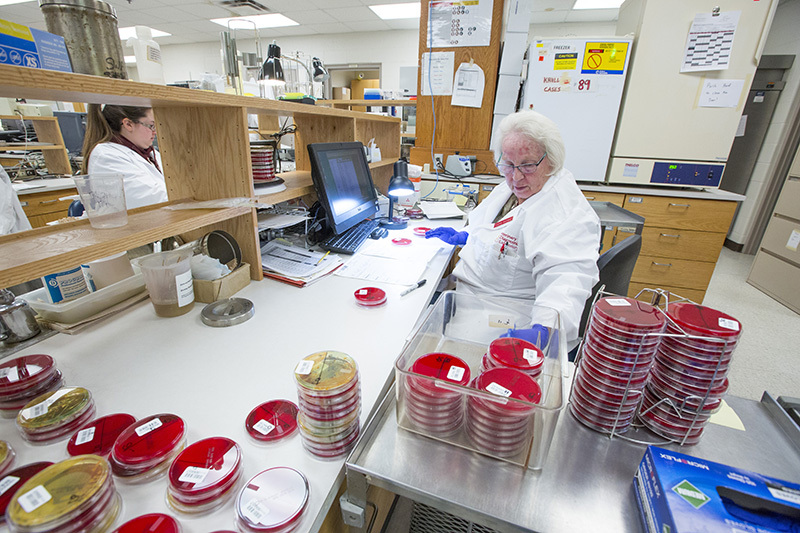
At the Veterinary Diagnostic Laboratory, Leona McDeid, right, works in the bacteriology section. Photos by Christopher Gannon.
A typical day at the Veterinary Diagnostic Laboratory (VDL) begins with opening the mail. Stacks of cardboard boxes containing samples to be tested -- chunks of brain, snippings of bovine ears, vials of blood, oral swabs -- arrive each morning in the same loading dock as the lab's supplies and bills.
Crews in the receiving room make quick work of each package. Using software custom-built by Iowa State, they verify, label and assign tracking markers to the submissions sent in by veterinarians from Iowa and across the U.S. Some samples come with specific instructions and head directly to the necessary labs. Others come from diseased animals and are passed to the on-duty diagnostician in the adjacent necropsy room, who assesses what tests are needed.
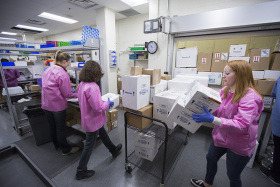
Workers unpack submitted testing samples in the Veterinary Diagnostic Lab's receiving room.
By midday, the receiving room that was bustling and cramped in the morning is largely quiet, many workers retreating to sections of the lab that conduct specific types of testing, such as virus identification, bacterial cultures or detection of toxins. Throughout the aging complex, technicians are preparing fluids and animal parts to be examined in increasingly varied ways. The heavy flow of case submissions is vital to Iowa's $32.5 billion livestock industry -- as well as a source of training for veterinary students and research for VDL faculty -- but it takes place in a facility ill-suited for the modern realties of animal agriculture.
The university plans to build a stand-alone laboratory to replace the VDL, a $124 million project that would solve its deficiencies in space, biosafety and biocontainment. For example, VDL staff and faculty test for contagious animal diseases inside the College of Veterinary Medicine complex, right next to the college's animal hospital, in labs that share airflow and access with the rest of the building. Main said there's no way to adequately protect against cross-contamination in the sprawling connected facilities, which have a combined square footage more than four times as large as Jack Trice Stadium's.
"We're a veterinary diagnostic lab dispersed throughout a building. We're not in a building built to house a world-class veterinary diagnostic lab," said Dr. Rodger Main, lab director.
New world, same space
In recent years, the VDL has been the nation's largest and busiest full-service diagnostic lab for food animals, Main said, processing nearly 86,000 cases in FY2017 -- more than double the 2009 caseload. When the lab opened in 1976, it processed 16,000 cases per year, and employed 10 faculty and 20 staff members. Twenty-five faculty and 125 staff work there now.
"It was a totally different world then. Iowa and U.S. animal agriculture have changed immensely, as has the scope and complexity of the diagnostic services provided," Main said.
Iowa State began studying the VDL's facility needs six years ago after two independent audits questioned the lab's biocontainment security and overcrowding, issues that could limit its ability to respond to large-scale disease outbreaks. To allow for the surge capacity an outbreak requires, for instance, Main said the receiving room where testing samples are opened, inventoried and routed would be roughly twice as large in the new facility -- and be served by a dedicated dock for deliveries.
Even after an outbreak passes, it leaves an impact on testing caseloads, Main said. The emergence of new diseases requires livestock producers to be even more diligent in their efforts to use state-of-the-art diagnostic tools to mitigate the impact, spread or entry of those diseases into their farms. The 86,000 cases in FY17 involved the lab conducting more than 1.25 million individual diagnostic tests.
"Today’s animal agriculturists are getting more sophisticated. They don't want sick animals," Main said. "It's precision agriculture. Practicing veterinarians and the producer clients are utilizing the laboratory not only to diagnose the cause of ill health or death, but they are ever increasingly using diagnostic tools as a mean of preventing disease”
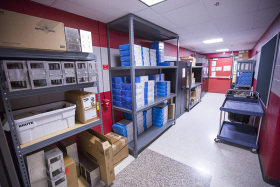
At the Veterinary Diagnostic Laboratory, many hallways double as storage space.
For example, the lab recently began testing swine with two new methods invented by Iowa State researchers and designed to monitor entire populations, Main said. One test collects fluids from tissues removed from newborn pigs, while the other gathers saliva samples from a rope hogs chew on, he said. Both methods are more sensitive and less intrusive than selecting random specimens for blood testing.
The lab also has been adding new equipment, such as machines that automatically fill test tube samples, to improve quality control and reduce repetitive motion by employees. That's a challenge in a facility where space is at a premium. At the VDL, closet-sized spaces often hold testing equipment, while hallways are flanked with refrigerators, filing cabinets and supply shelves. The proposed new facility calls for increasing the lab's size by about 30 percent, to 150,000 gross square feet.
Finding funding
VDL clientele pay for the bulk, about 80 percent, of the lab's operational expenses, along with $4 million in a direct state appropriation from the Iowa Department of Agriculture and Land Stewardship, some federal funding and university support for salaries.
But building a new facility will require additional state assistance. Iowa State's proposal calls for $100 million in appropriations spread over five years, along with $24 million in private donations and university funding. A recent study by ISU economists found the annual state funding for the lab delivers a high return on investment, 8-to-1 during normal years and four times that during an outbreak.
The project wasn't included in early budget bills proposed this session by state lawmakers, but Gov. Kim Reynolds, in her proposed FY19 budget, recommended funding the project beginning in FY20. The mention in the governor's budget proposal was encouraging, but if the Legislature doesn't make a full funding commitment this session, even $5 million to begin formal project planning would be extremely helpful, Main said.
Tentative plans call for building the new lab building on the southwest corner of the College of Veterinary Medicine campus. Main said the project includes the cost of renovating the lab's existing space into research and teaching areas. That's a significant side benefit for the college, which has at times struggled to recruit elite researchers due to space concerns, he said.
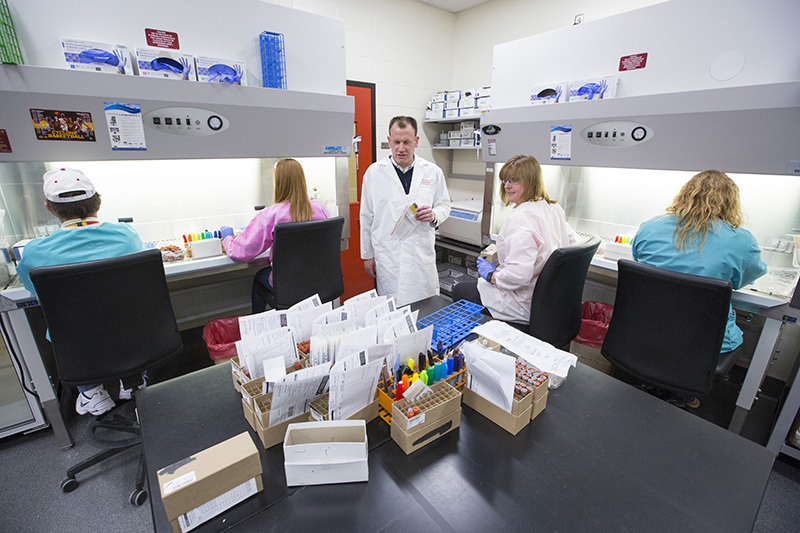
Veterinary Diagnostic Laboratory director Rodger Main, center, visits with workers in the receiving room.
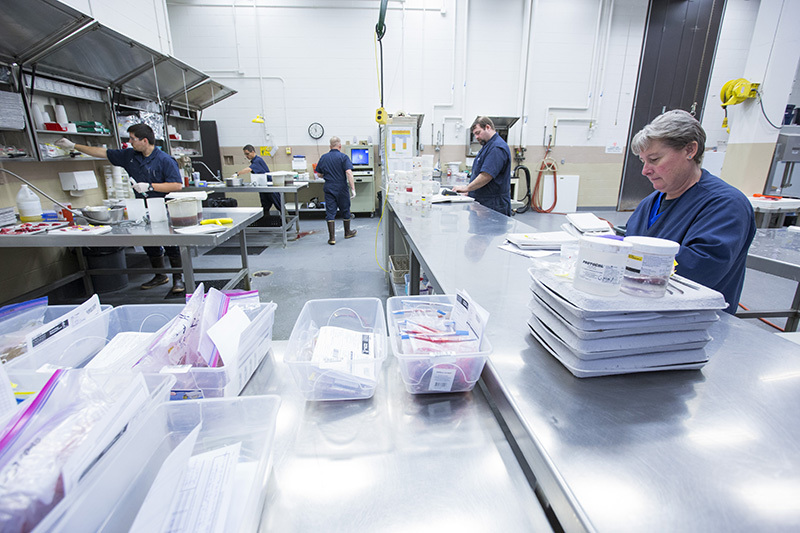
Dr. Vickie Cooper, right, examines incoming tissue samples in the necropsy room of the Veterinary Diagnostic Laboratory.
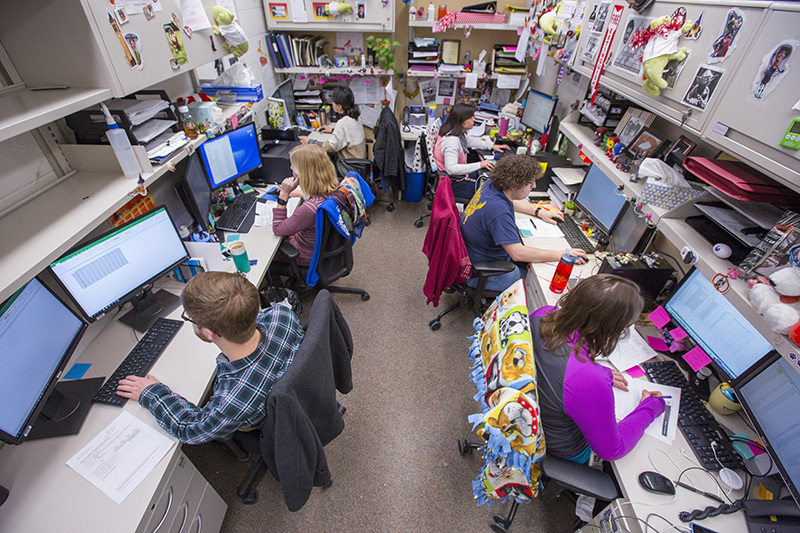
Staff crowded into a small office space at the Veterinary Diagnostic Laboratory.
Wintersteen presents ISU request to legislators
Presenting the university's annual appropriations request to the Legislature Feb. 21, President Wendy Wintersteen said funding for public higher education shouldn't be viewed as a cost, but an investment in the state's economic health. Wintersteen and her regent institution peers testified this year before the House Appropriations Committee.
Iowa State's state funding proposal for the year that begins July 1 hasn't changed since September and features two requests for new funds:
- $5 million in additional operating support, all of which would be used for resident undergraduate financial aid. Sixty percent of ISU undergraduates (more than 18,200 students) come from Iowa, she noted.
- A five-year, $100 million commitment to replacing the Veterinary Diagnostic Laboratory with a stand-alone, state-of-the-art facility. The estimated total cost for the project is $124 million.
As the state's only full-service animal diagnostic lab, Wintersteen said the VDL plays a critical role in securing Iowa's $32.5 billion animal agriculture industry. The site visit team that accredited the lab last fall identified significant concerns about the physical limitations of the lab, raising doubt about another accreditation, she said.
Financial challenge
Wintersteen said Iowa State's financial challenge is shaped by three developments:
- Enrollment growth of nearly 10,000 students since 2009
- Resident undergraduate tuition that has been the same for seven of the last 12 semesters
- State base operating support that is trending downward, including an $11.6 million reduction from July 1, 2016 to July 1, 2017
One result has been a "huge jump" in the faculty teaching load in the last decade, on average, 71 percent. Teaching more students and more credit hours is a good thing, to a point, Wintersteen said.
"But we've reached the point where we've stretched the university too thin. Our faculty and staff are maxed out," she said. "We are tipping the balance between efficiency, educational quality and accessibility."
Unique role in the state
Wintersteen said Iowa State's land-grant status, particularly its responsibility to share and apply the knowledge it creates, provides unique value for the state. She cited entrepreneurial programming that creates jobs and attracts external funding, research and service that assists existing businesses in every Iowa county and resources for Iowansof all ages through ISU Extension and Outreach.
However, the university's greatest economic asset is its graduating students, Wintersteen, said. Of last May's 4,860 graduates, 52 percent stayed in Iowa. Fifty-six percent of the student body is majoring in agriculture or STEM fields, highly valuable to the state's future workforce.
"As a land-grant institution, we derive our value by helping Iowans and the state be successful," Wintersteen said. "This has been our mission for 160 years, and it is as relevant and critical today as it ever has been."
ISU Extension and Outreach VP finalists set to visit campus
Four finalists have been identified in the search for the next vice president of ISU Extension and Outreach. All four will interview on campus before spring break.
Candidate visits will take two days. Each finalist's name will be made public one business day before his or her visit. Finalists will meet with faculty and staff, visit a county extension office and hold an open forum in the Memorial Union at 3 p.m. on the first day of the visit:
- Candidate 1: Monday, Feb. 26, Gallery
- Candidate 2: Wednesday, Feb. 28, Gallery
- Candidate 3: Monday, March 5, Sun Room
- Candidate 4: Tuesday, March 6, Gallery
Candidate information will be posted on the provost office's search page.
Okta secure login debuts March 1
Learn more
An introduction to Okta and short learning videos are available on the WorkCyte website.
Your Iowa State login page will look a little different when you go online March 1. That's when campus takes another step in a shift to the Okta identity and access security platform.
"We're rolling out Okta in multiple phases," said Darin Dugan, identity services manager in information technology. "This phase makes Okta the primary login for web applications."
The look may change, but the request for a Net-ID and password will not. Just like the current page, this one will appear for access to any web-based services or applications that currently require ISU login credentials -- for example, Canvas, Cybox, Office 365, PeopleAdmin or Qualtrics. Dugan said it also includes Iowa State services and sites limited to campus access, such as Learn@ISU or WorkCyte.
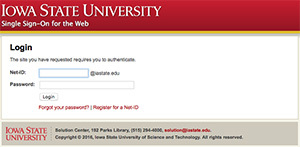
Current login screen
"All that means for users is that when they sign in, the page they're used to seeing will be replaced with a new login page," Dugan said. "We went the route of minimal impact to the campus community."
Once logged in, users can access other web-based applications that require an ISU Net-ID and password without re-entering their credentials. However, users must sign in on each web browser they use. Credentials are valid until the user quits the web browser or, for early adopters and advanced users, signs out on the Okta dashboard.
Take it a step further
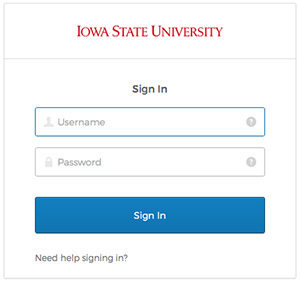
Okta login
Dugan said more than 700 people opted in as Okta early adopters. Users still can jump ahead of the phased Okta rollout by setting up multifactor authentication (MFA) and a personalized dashboard.
"Right now, users can go about business as usual," Dugan said. "If they want to take advantage of the dashboard or MFA enrollment, they can go to the Okta sign-in page."
MFA options and dashboards can be set up by accessing the Okta sign-in page directly (login.iastate.edu). It also will be added to the "Sign Ons" link in the top right corner of the university homepage. Target dates aren't yet set for the next phases of the campuswide switch.
"Once we understand the impact of MFA and the steps needed to enable it campus wide, we'll pick a date when MFA enrollment is required," Dugan said.
Related stories
- Get a feel for Okta as an early adopter, Jan. 25, 2018
- Another tool for cybersecurity , Nov. 2, 2017
- New platform will provide portal to multiple applications , April 20, 2017
Big west-side road projects will span two summers
Several significant west campus projects that combine underground utilities and road replacement will be coordinated on one timeline over the next two springs and summers. In phases (see map below), sections of Bissell Road, Union Drive and Welch Road will close temporarily, but by the end of summer 2019:
- Large chilled water pipes will be added beneath Bissell Road between Osborn and Union drives, expanding the capacity of the 50-year-old system in this area of campus. Buildings in the west and southwest parts of campus will be much easier to cool.
- Larger storm sewer lines will be installed beneath Bissell and Union between Osborn and College Creek. This will replace an undersized 78-year-old storm sewer installed when west campus was mostly undeveloped.
- In concert with the utility work, sections of Union, Bissell and Welch roads will be removed and reconstructed. The new narrower roads and wider sidewalks are designed for pedestrian safety and will comply with federal accessibility requirements.
"These projects will pay dividends on the west side of campus for a long, long time," said assistant director for utilities Randy Larabee.
Weather permitting, the work will begin on the first day of spring break this year and next. The goal is to wrap up before thousands of new Iowa Staters arrive to campus in mid-August, said Angie Solberg, facilities planning and management project manager on the Welch Road-Union Drive reconstruction. The jobs are too large to complete during the 12-13 weeks of summer, she noted. A spring break start is preferred to beginning in May and working into late September, she added.
Learn more
FPM slides on 2018 project phases (PDF)
2018: Bissell
On March 12, Bissell Road will close adjacent to the Student Innovation Center construction site so new storm and chilled water lines can tie into that project. In early June, the utility project will move north, from the west side of Sweeney Hall to nearly the Osborn intersection. Around mid-July, the final 2018 phase will close the Bissell-Osborn intersection until about Aug. 10.
Larabee said a temporary north-south pedestrian walkway will be maintained on the west side of Bissell during the project. East-west pedestrian crossings through the project will move as needed but stay well marked.
The parking lots south of Howe (lot 3) and Hoover (lot 8) halls will remain accessible this summer. Bissell Road's lot 14 (reserved and handicapped parking) will permanently move up the street to west of the Armory.
2018: Welch-Union
Also on March 12, Welch Road will close at Lincoln Way for approximately 60 yards north. In early May, the second phase, north to just short of the Enrollment Services Center entrance and including the intersection with Union Drive, will begin. The final phase of 2018, from early July to early August, will proceed farther north, to just beyond the Enrollment Services Center entrance (parking lot 65). Road replacement will include reshaping this entrance and adjacent sidewalks and building a new east-end entrance to parking lot 5 south of the Student Services Building.
Lots 5 and 4 (south of Lab of Mechanics) will remain accessible this year. Solberg said there will be a pedestrian walkway on at least one side of Welch and Union throughout the project.
Up to eight CyRide bus routes use roads that will close for this work. Route detours aren't finalized yet, but generally CyRide buses will use Sheldon (northbound) and Hyland (southbound) avenues as alternatives to Bissell, and Lincoln Way instead of Union.
2019
In March 2019, work will recommence. Underground utility and road/sidewalk replacement next summer will fill the "L" from approximately the Howe Hall front doors south to just short of the rebuilt Enrollment Services Center/lot 5 driveway.
When it's done, the road corridor from the Bissell/Osborn intersection south to the Lincoln Way/Welch intersection will look and function consistently. Road widths will narrow from as wide as 40 feet to a uniform 27 feet, and sidewalks will widen to 10 feet. A single traffic lane in each direction (13.5 feet wide) will be shared by vehicles, buses and bicycles. The Union Drive bus stop near the Enrollment Services Center will be consolidated with the larger stop near Lab of Mechanics, and lighting and landscaping throughout the corridor also will be replaced.
"The priority is to protect pedestrians in some very heavily traveled zones," Solberg said. "In effect, the narrower road lanes may encourage 'through' drivers trying to get to another part of campus to choose an alternate route."
The utilities work, estimated at $6.5 million, will be covered by ISU utility infrastructure funds. The $3.2 million Welch-Union road replacement project will be paid for also with ISU utility infrastructure funds and institutional road funds (state funds from a road use tax on gasoline).
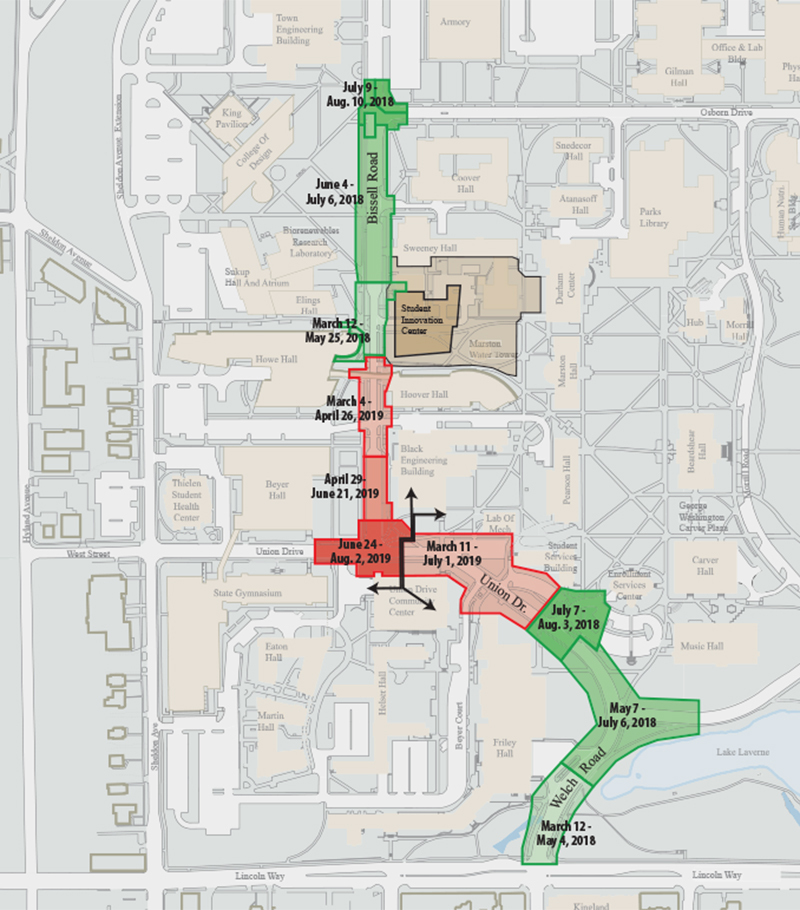
The utility and road work on the west side of campus will be phased during the spring and summer of 2018 (green) and 2019 (red) as shown. Image courtesy of facilities planning and management.
Consultants have safety recommendations for Lincoln Way
Consultants assisting with a Lincoln Way pedestrian safety study in the vicinity of the Iowa State campus will present their improvement recommendations to university and city audiences Feb. 27. Staff from SRF Consulting Group, Omaha, will lead a public session at 3:30 p.m. in 2105 Pearson. They also will present during the Ames City Council meeting that evening, which begins at 5:30 p.m. in the council chambers, Ames City Hall.
Presentation
Feb. 27: 3:30 p.m., 2105 Pearson
Since August, phase 2 of the joint city-university traffic study has focused on three ideas the consultants and city traffic staff believe could improve safety on Lincoln Way:
- Alter the timing of traffic signals on Lincoln Way to reduce wait times for all travelers (pedestrians crossing the road, bicyclists and drivers traveling through the corridor)
- Address the Welch Avenue-Lincoln Way intersection, which has a higher-than-expected severe crash rate
- Address the Stanton Avenue-Lincoln Way intersection, a heavily used pedestrian crossing site with a vehicle crash rate trending upward and no crosswalk or signal
Recommendations could include simple solutions such as adding lead time to walk signals for pedestrians before vehicles are allowed into an intersection. This practice recently was adopted at University Boulevard's intersections with Sixth Street and Stange Road. Solutions also could include physical modifications, for example altering street medians or curb corners to better protect pedestrians or adding a marked crosswalk where there isn't one.
Cathy Brown, assistant director for planning in facilities planning and management and a liaison to the city on this project, said student leaders, the university's transportation advisory council members and student affairs and university services representatives have been invited to the afternoon campus session. Other members of the campus community are welcome at either session.
Last month, Student Government also created a task force on pedestrian safety to study issues and solutions along Lincoln Way. Brown said the Lincoln Way study team shared its phase 1 data with task force members. The student group is supposed to submit its report to president Cody West by March 23.
Related stories
Lincoln Way safety study heads into solutions phase, Aug. 3, 2017
ISU, city team on Lincoln Way safety study, March 24, 2016
A Greek tragedy, with a twist
A new wind will blow into Fisher Theater, bringing a Greek drama to life with contemporary flair. Audiences can expect a combination of music, puppetry and classical language in ISU Theatre's production of "Iphigenia," which opens a two-weekend run on Friday, Feb. 23.
"We're really excited to share what we think is an engaging and relevant ancient story in a new way," said Amanda Petefish-Schrag, assistant professor in theater and the show's director. "It's some things we haven't done a lot of on the Iowa State stage -- incorporating puppetry into a production with classical acting that one might expect in any Greek tragedy. That layering of approaches is part of what we think makes this fun and dynamic."
Petefish-Schrag worked with her husband, Ben Schrag, on the adaption. She said it's a story they've been drawn to for quite some time.
"For a story that's thousands of years old, it has some really interesting questions that I think resonate contemporarily," Petefish-Schrag said. "Our hope in doing an adaptation was to take so much of what works really well for a classical Greek tragedy and think about it in terms of how it connects with an audience of people in Ames, Iowa, in 2018."
As in the original work written by Euripides around 400 BC, Greek general Agamemnon is told to sacrifice his eldest daughter, Iphigenia, to earn favorable winds from the goddess Artemis, and send his thousand ships to war against Troy. The struggle of the characters -- within themselves and among each other -- fuels the drama.
Puppetry allows the 14-member cast to play multiple roles, while a three-person band performs an original score. The one-act play features episodes, separated by choral odes.
"We are incorporating puppets in places where the ancient Greeks might have used masks to portray important characters," Petefish-Schrag said. "In classical tragedy, there are choral odes that come between each scene -- and there's good evidence that those were sung by the ancient Greeks. We have set those choral odes to music as well, but incorporating more contemporary music. We're using an old technique and layering it with a more contemporary approach."
Show times for "Iphigenia" are 7:30 p.m. on Feb. 23-24 and March 2-3, and 2 p.m. on Feb. 25 and March 4. Tickets are $18 ($16 for seniors and $11 for students), available on Ticketmaster, at the Stephens box office or at the Fisher Theater door.
